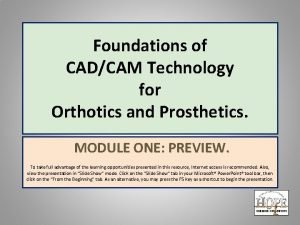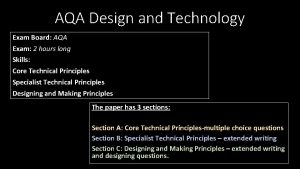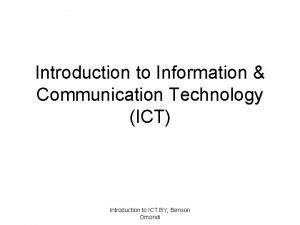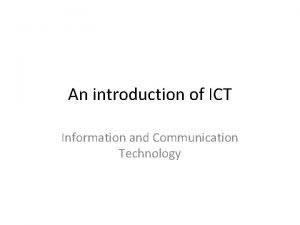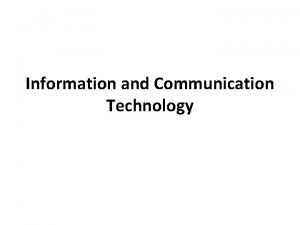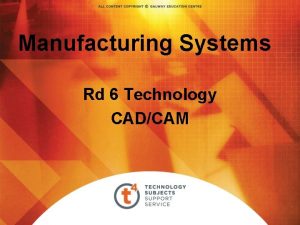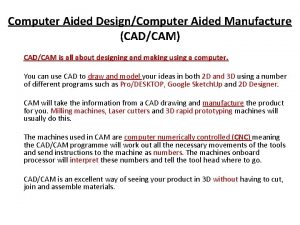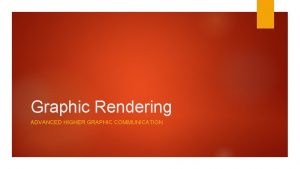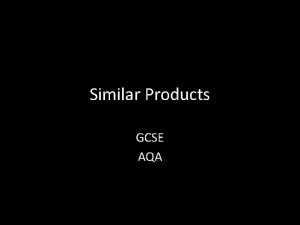CADCAM AQA Graphic Products Information and communication technology









- Slides: 9

CAD/CAM AQA Graphic Products

Information and communication technology Learning Objectives By the end of this lesson you will have developed a knowledge and understanding of: • the component parts of a CAD/CAM system • different CAD/CAM and ICT input and output devices and their function • selecting appropriate CAD, ICT and graphic software • benefits and costs of CAD/CAM and ICT

Key terms • A graphic designer using computers will need to know several key terms. CAD: Computer Aided Design CAM: Computer Aided Manufacturing Hardware: The physical components attached to a computer system Software: The computer programmes used.

CAD A CAD system uses information and computer technology (ICT) to aid in the design of a part or product. • You will know this by the software programmes you use at school. These programmes allow you to draw, create and visualise your ideas on screen. The software you use could include: – Adobe Photoshop – Solidworks / Google Sketchup – Techsoft 2 D design … and many more.

Software • Photoshop® is a photo editing software. It can change and enhance colour and pictures. It has a wide range of effects that will visually enhance your design. • Solidworks/Google Sketchup® is a 3 D solid modelling software. A 3 D shape can be designed and, by dragging the mouse, can be viewed from any angle. This give the designer the opportunity to see the 3 D form. Solid modelling software will also generate working drawings, photo renderings and out put to CNC machining. • Techsoft 2 D design is a VECTOR software for drawing 2 D shapes. Vector means that the lines are not pixels on a screen, the lines are mathematically linked. If you have connecting lines and drag an end of one, the other connected lines will also move.

Graphics software • Desktop publishing (DTP) software is used in graphic design for general image editing and page layouts. It is used by newspapers and magazines to design the layouts and set the output ready for print production.

CAM A CAM system uses computer-controlled machine tools to manufacture products drawn using CAD programs. • CAM usually requires quite expensive hardware to create and bring your virtual designs into the physical world. The hardware could include: – Printers – Laser cutters – Vinyl cutters – CNC routers/lathes and milling machines – Plotters – Rapid prototyper / 3 D Printer

Benefits and Disadvantages of CAD/CAM and ICT Benefits: • Higher productivity – standard orthographic drawing can be produced almost immediately after design completed. • Reduced design time – shortcuts are available and work can be completed quickly when you are familiar with its features. • Less time required for modifications – drawings can be seen on the screen, and mistakes and modifications can be seen in 3 D or magnified using zoom features. • Ability to repeat designs – designs can be altered without erasing and redrawing. It is easy to include variations. • More accurate designs – standard components can be combined to make new designs quickly. Presentation drawings can be life-like in quality. Disadvantages: • Cost – expensive to purchase the software and hardware. • Training – if the operator is not familiar with the CAD system, it is difficult to use. • Technology – if there is a computer problem, all data will be lost.

Advantages and disadvantages of CAM Advantages of CAM • Accuracy – product components are made to a specification and to numbers required. • Flexibility – modern CAD production allows the quick interchange of tooling so that a range of products can be programmed into the machine. • Stamina – manufacturing is non-stop; the machines never get tired or need a break. • Maintenance – faults can be predicted and the machine only stopped for routine servicing. Disadvantages of CAM • Breakdown – specialist engineers and expensive parts may be required to repair the machines. • Poor design – an inaccurate or poor design will produce a poor product. Rubbish in equals rubbish out. • Waste – if the CAD system runs without checking mistakes, the machines can produce large amounts of costly scrap.
 Cadcam orthotics
Cadcam orthotics Aqa design and technology past papers
Aqa design and technology past papers Ghost graphic story graphic and wayfinding
Ghost graphic story graphic and wayfinding Information communication technology conclusion
Information communication technology conclusion Introduction to information and communication technology
Introduction to information and communication technology Information and communication technology capability.
Information and communication technology capability. Introduction of ict
Introduction of ict Meaning of information and communication technology
Meaning of information and communication technology Components of information and communication technology
Components of information and communication technology Definition information and communication technology
Definition information and communication technology
